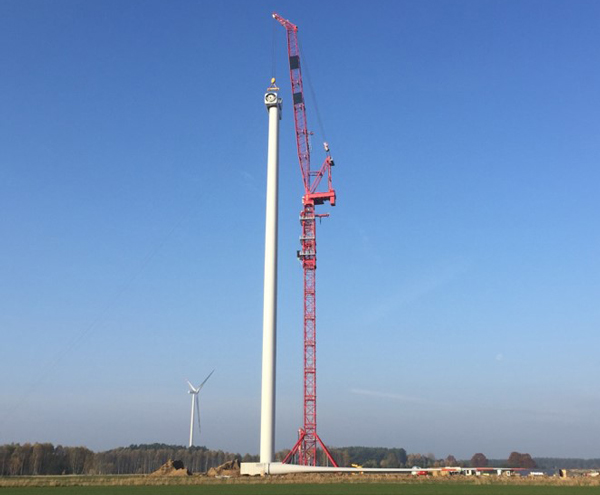
Time is money. As trite as this empty
phrase appears, if it concerns the construction
of wind farms, then it is as
current as it has ever been. For this
reason, and of course due to the increasing
demand for renewable energy, the Danish
crane manufacturer Krøll has developed a
new luffng jib crane which takes into account
the special requirements of the wind industry.
The new Krøll K1500L has a capacity of 125 t
up to a radius of 12.5 m and can construct
wind turbines of the 5MW class to a height of
170 m. In the process the crane operates very
close to the tower and in a very small turning
circle, as is typical for luffng jibs. In this case,
Krøll has gone a step further and designed
the K1500L in such a way that allows for
the positioning of a very steep jib in order to
reach the necessary lifting height. This steep
deployment angle of the 70.1 m long jib does
increase the risk of instability during sudden
gusts of wind or down draughts, however. To
counteract this, the very steep A gantry uses
a spring damping system which stops the jib
from falling below the minimum radius.
The complex usage and construction of the
crane places the most extreme demands on
all crane components. For this reason, Krøll decided
to place their trust in special wire cables
made by CASAR. The 825 m CASAR Eurolift
Ø 40 mm hoist rope was put to use here, a
rotation-resistant rope, which has proved its
exceptional qualities over decades. The hoist
rope is reeved with four strands. The hoisting
winch, with a capacity of 154 kW, can lift a
load at a rate of 6 m/min and up to 22 m/min
when bearing no load.
The luffng jib rope is a CASAR Turboplast,
a compacted 8-strand Warrington-Seale construction
with a plastic-covered steel core.
What the K1500L is able to achieve has been
proven many times over during the course
of the last four months. To begin with, the
crane was put through its paces under socalled
laboratory conditions on the Krøll test
field in Lynge, close to Copenhagen. The
crane passed its 100 % load test (125 t) as
well as its overload test at 125 % (156.25 t)
with ying colours. This was followed at
the end of last year with the first field
test in Poland. Here, a prominent Danish
manufacturer‘s wind turbines were successfully
installed.
One of the greatest strengths of the K1500L
is certainly that it is a free-standing crane that
does not need to be anchored to the ground. Its
sophisticated construction makes it very fexible.
The crane is disassembled into relatively
large sections at the wind farm building site
for transport over relatively short distances,
so that it can be ready for use again as quickly
as possible. If further transport on public
roads is required, the crane is disassembled
into a larger number of smaller and lighter
sections, in order to enable easier transportation.
In this way, the M33 Monoblock tower
system meets the size requirements for road
transport.